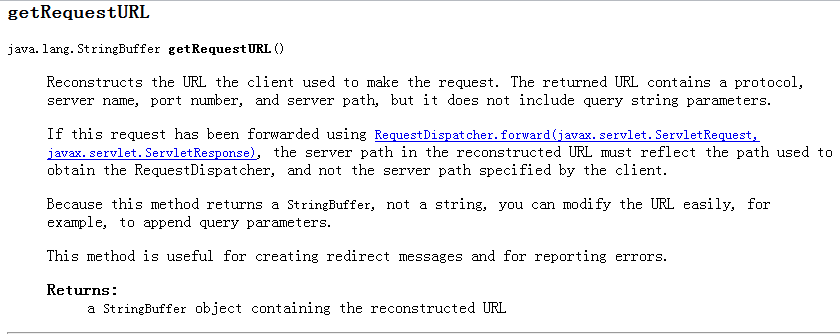Nginx SSL+tomcat集群,request.getScheme() 取到https正确的协议
2021-06-08 01:03
瞬间要颠覆我的Java观 ,API上写得很清楚:
,API上写得很清楚:
getRequestURL():

- Reconstructs the URL the client used to make the request.
- The returned URL contains a protocol, server name, port number, and server path,
- but it does not include query string parameters.
也就是说, getRequestURL() 输出的是不带query string的路经(含协议,端口,server path等信息).

并且,还发现

- request.getScheme() //总是 http,而不是实际的http或https
- request.isSecure() //总是false(因为总是http)
- request.getRemoteAddr() //总是 nginx 请求的 IP,而不是用户的IP
- request.getRequestURL() //总是 nginx 请求的URL 而不是用户实际请求的 URL
- response.sendRedirect( 相对url ) //总是重定向到 http 上 (因为认为当前是 http 请求)
查阅了一些资料,找到了解决方案:
解决方法很简单,只需要分别配置一下 Nginx 和 Tomcat 就好了,而不用改程序。
配置 Nginx 的转发选项:

- proxy_set_header Host $host;
- proxy_set_header X-Real-IP $remote_addr;
- proxy_set_header X-Forwarded-For $proxy_add_x_forwarded_for;
- proxy_set_header X-Forwarded-Proto $scheme;
proxy_set_header X-Forwarded-Proto $scheme;
配置Tomcat server.xml 的 Engine 模块下配置一个 Valve:

- Valve className="org.apache.catalina.valves.RemoteIpValve"
- remoteIpHeader="X-Forwarded-For"
- protocolHeader="X-Forwarded-Proto"
- protocolHeaderHttpsValue="https"/>
配置双方的 X-Forwarded-Proto 就是为了正确地识别实际用户发出的协议是 http 还是 https。
这样以上5项测试就都变为正确的结果了,就像用户在直接访问 Tomcat 一样。
关于 RemoteIpValve,有兴趣的同学可以阅读下 doc
http://tomcat.apache.org/tomcat-6.0-doc/api/org/apache/catalina/valves/RemoteIpValve.html

- Tomcat port of mod_remoteip, this valve replaces the apparent client remote IP address and hostname for the request with the IP address list presented by a proxy or a load balancer via a request headers (e.g. "X-Forwarded-For").
- Another feature of this valve is to replace the apparent scheme (http/https) and server port with the scheme presented by a proxy or a load balancer via a request header (e.g. "X-Forwarded-Proto").
看了下他们的源码,比较简单,在各种框架,各种算法面前,这个类对性能影响很小
- 如果没有配置protocolHeader 属性, 什么都不做.
- 如果配置了protocolHeader,但是request.getHeader(protocolHeader)取出来的值是null,什么都不做
- 如果配置了protocolHeader,但是request.getHeader(protocolHeader)取出来的值(忽略大小写)是配置的protocolHeaderHttpsValue(默认https),scheme设置为https,端口设置为 httpsServerPort
- 其他设置为 http

- if (protocolHeader != null) {
- String protocolHeaderValue = request.getHeader(protocolHeader);
- if (protocolHeaderValue == null) {
- // don‘t modify the secure,scheme and serverPort attributes
- // of the request
- } else if (protocolHeaderHttpsValue.equalsIgnoreCase(protocolHeaderValue)) {
- request.setSecure(true);
- // use request.coyoteRequest.scheme instead of request.setScheme() because request.setScheme() is no-op in Tomcat 6.0
- request.getCoyoteRequest().scheme().setString("https");
- request.setServerPort(httpsServerPort);
- } else {
- request.setSecure(false);
- // use request.coyoteRequest.scheme instead of request.setScheme() because request.setScheme() is no-op in Tomcat 6.0
- request.getCoyoteRequest().scheme().setString("http");
- request.setServerPort(httpServerPort);
- }
- }
参考:
SSL证书与Https应用部署小结
http://han.guokai.blog.163.com/blog/static/136718271201211631456811/
上一篇:js的RegExp
下一篇:初探webService
文章标题:Nginx SSL+tomcat集群,request.getScheme() 取到https正确的协议
文章链接:http://soscw.com/essay/91989.html